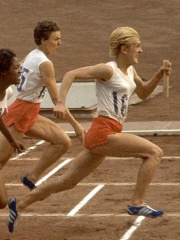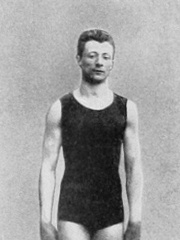







The Most Famous
ATHLETES from Poland
This page contains a list of the greatest Polish Athletes. The pantheon dataset contains 6,025 Athletes, 288 of which were born in Poland. This makes Poland the birth place of the 11th most number of Athletes behind China, and Netherlands.
Top 10
The following people are considered by Pantheon to be the top 10 most legendary Polish Athletes of all time. This list of famous Polish Athletes is sorted by HPI (Historical Popularity Index), a metric that aggregates information on a biography's online popularity. Visit the rankings page to view the entire list of Polish Athletes.

1. Stanisława Walasiewicz (1911 - 1980)
With an HPI of 66.31, Stanisława Walasiewicz is the most famous Polish Athlete. Her biography has been translated into 34 different languages on wikipedia.
Stanisława Walasiewicz (3 April 1911 – 4 December 1980), also known as Stefania Walasiewicz, and Stella Walsh, was a Polish-American track and field athlete, who became a women's Olympic champion in the 100 metres. Born in Poland and raised in the United States, she became an American citizen in 1947.

2. Gustav Flatow (1875 - 1945)
With an HPI of 63.88, Gustav Flatow is the 2nd most famous Polish Athlete. His biography has been translated into 26 different languages.
Gustav Felix Flatow (7 January 1875 – 29 January 1945) was a German gymnast. He competed at the 1896 Summer Olympics in Athens and at the 1900 Summer Olympics in Paris. Flatow was Jewish, and was born in Berent, West Prussia. In 1892, he moved to Berlin.

3. Myer Prinstein (1878 - 1925)
With an HPI of 62.70, Myer Prinstein is the 3rd most famous Polish Athlete. His biography has been translated into 28 different languages.
Myer Prinstein (born Mejer Prinsztejn, December 22, 1878 – March 10, 1925) was a Poland-born American track and field athlete who held the world record for the long jump in 1900 and won four gold medals in three Olympic Games for the long jump and triple jump. He was a member of the Irish American Athletic Club in Queens, New York. A 1902 law graduate and track team captain for Syracuse University, after college he became a New York real estate lawyer and businessman while living in Jamaica Plains, Queens. To date, he is the only Olympic track athlete to win both the triple and long jump in the same Olympics, earning the distinction in St. Louis in 1904.

4. Hans Woellke (1911 - 1943)
With an HPI of 61.91, Hans Woellke is the 4th most famous Polish Athlete. His biography has been translated into 28 different languages.
Hans-Otto Woellke (18 February 1911 – 22 March 1943) was a Nazi German shot putter, who won a gold medal at the 1936 Summer Olympics.

5. Ewa Kłobukowska (b. 1946)
With an HPI of 60.71, Ewa Kłobukowska is the 5th most famous Polish Athlete. Her biography has been translated into 30 different languages.
Ewa Janina Kłobukowska (born 1 October 1946) is a Polish former sprinter. She competed at the 1964 Olympics in the 4 × 100 m relay and 100 m sprint and won a gold and a bronze medal, respectively. She also won two gold and one silver medal at the 1966 European Athletics Championships. Kłobukowska set three world records, one in the 100 m (11.1 s, 9 July 1965 in Prague) and two in the 4 × 100 m relay (44.2 s, 13 September 1964, Łódź and 43.6 s, 21 October 1964, Tokyo). Kłobukowska was at one point considered to be the fastest woman in the world. The American Press made a statement, saying that nobody would beat Kłobukowska for the next 7–8 years following a race in Prague. Despite these successes and laurels, her records were annulled by the International Association of Athletics Federations (IAAF) after a sex identification test in 1967 incorrectly labeled her as not female. The test procedures were later determined to be inadequate.

6. Janusz Kusociński (1907 - 1940)
With an HPI of 60.39, Janusz Kusociński is the 6th most famous Polish Athlete. His biography has been translated into 31 different languages.
Janusz Tadeusz Kusociński (15 January 1907 – 21 June 1940) was a Polish athlete, winner in the 10,000 meters event at the 1932 Summer Olympics.

7. Ursula Happe (1926 - 2021)
With an HPI of 59.82, Ursula Happe is the 7th most famous Polish Athlete. Her biography has been translated into 23 different languages.
Ursula Happe (German pronunciation: [ˈʊʁzula ˈhapə] ; 20 October 1926 – 26 March 2021) was a German swimmer and Olympic champion. She competed at the 1956 Olympic Games in Melbourne, where she won the gold medal in 200 m breaststroke. She also competed in the women's 200 metre breaststroke at the 1952 Summer Olympics. Happe died in Dortmund on 26 March 2021 at the age of 94. Her son Thomas Happe is a former international handball player for West Germany.

8. Józef Szmidt (1935 - 2024)
With an HPI of 59.82, Józef Szmidt is the 8th most famous Polish Athlete. His biography has been translated into 31 different languages.
Józef Szmidt (born Josef Schmidt; 28 March 1935 – 29 July 2024) was a German and Polish Olympic athlete and the first triple jumper to reach 17 metres.

9. Elżbieta Krzesińska (1934 - 2015)
With an HPI of 59.06, Elżbieta Krzesińska is the 9th most famous Polish Athlete. Her biography has been translated into 29 different languages.
Elżbieta Maria Krzesińska (née Duńska; November 11, 1934 – December 29, 2015) was a track and field athlete from Poland, who competed in the long jump. Born in Warsaw, she competed for her native country at the 1956 Summer Olympics held in Melbourne, Australia where she won the gold medal in the Women's Long Jump. She returned to the 1960 Summer Olympics in Rome but failed to defend her title, finishing second behind Soviet Vera Krepkina. She won the Polish championships in Long Jump (1952, 1953, 1954, 1957, 1959, 1962, 1963), 80m Hurdles (1957), and Pentathlon (1953, 1962). Duńska-Krzesińska participated in three Olympic Games. In 1952, she took 12th place in long jump at the 15th Olympic Games in Helsinki. In 1956, she won gold medal at the 16th Olympic Games in Melbourne. In 1960, she won silver medal, behind Vera Krepkina, at the 17th Olympic Games in Rome. In 1954, she took 3rd, behind Jean Desforges, and Aleksandra Chudina, at the 5th European Championships in Athletics in Bern. In 1954, she won both in long jump and pentathlon at World Student Games in Budapest. In August 1956, she broke the world record in long jump (6.35) in Budapest, and equal in November 1956 in the Melbourne Olympics. In 1959, she won at the 1st Universiade in Turin. In 1962, she took 2nd, behind Tatyana Shchelkanova, at the 7th European Athletics Championships in Belgrade. She was married to fellow Olympian Andrzej Krzesiński and they competed together at the 1960 Summer Olympics. She lived in the United States of America from 1981 until 2000, then she came back to Poland. She died on 29 December 2015 after long illness.

10. Gerhard Stöck (1911 - 1985)
With an HPI of 58.74, Gerhard Stöck is the 10th most famous Polish Athlete. His biography has been translated into 24 different languages.
Gerhard Karl Eduard Stöck (28 July 1911 – 29 March 1985) was a German athlete and Nazi officer. He won the gold medal in the javelin throw event at the 1936 Summer Olympics and placed third in the shot put. Stöck was the son of a butcher. He was born in Kaiserswalde in 1911, a small village now located in Poland, and grew up in the Province of Posen. He was a versatile athlete and, besides throwing events, competed in decathlon and won the javelin and pentathlon events at the 1935 World Student Games. Domestically, he won the German javelin title in 1938 and placed second in 1933–1947. He never won the German shot put title, due to a strong competition from Hans Woellke, and placed second four times. At the 1938 European Championships, Stöck won a silver medal in the shot put, surprisingly beating Woellke, but placed only seventh in the javelin throw. Stöck had a degree in philology and worked as a teacher from 1938. Earlier in 1933, he became a member of the Nazi paramilitary organization, the Sturmabteilung and, in 1944, was promoted to SA-Sturmbannführer. In the lead up to Operation Uranus, Stöck was the one who reported an expected Soviet attack that day to General Schmidt's division, this attack was the first of the operation. The message was not passed on to Schmidt however as it was thought to be another false alarm. This lack of early response is thought to have contributed to the Soviet success of Operation Uranus. After World War II, he continued competing until the early 1950s and then worked as a sports administrator. He served as Chef de Mission of the Unified German Olympic team in 1956 and 1960 and as deputy chef de mission in 1964. His past military activity was raised only after his death in 1985. Among other things, it was found that he falsified his birth year from 1911 to 1910. Stöck was married and raised an athletic family. His daughter, Jutta Stöck, became an Olympic sprinter, while his son-in-law, Peter Hertel, was a 1966 world champion in rowing. His grandson, Ole Hertel, was a competitive shot putter and discus thrower.
People
Pantheon has 288 people classified as Polish athletes born between 1100 and 2003. Of these 288, 238 (82.64%) of them are still alive today. The most famous living Polish athletes include Ewa Kłobukowska, Halina Górecka, and Dieter Grahn. The most famous deceased Polish athletes include Stanisława Walasiewicz, Gustav Flatow, and Myer Prinstein. As of April 2024, 22 new Polish athletes have been added to Pantheon including Robert Felisiak, Renata Nielsen, and Piotr Kiełpikowski.
Living Polish Athletes
Go to all RankingsEwa Kłobukowska
1946 - Present
HPI: 60.71
Halina Górecka
1938 - Present
HPI: 55.79
Dieter Grahn
1944 - Present
HPI: 53.35
Jerzy Kaczmarek
1948 - Present
HPI: 53.10
Meinhard Nehmer
1941 - Present
HPI: 52.86
Jacek Wszoła
1956 - Present
HPI: 52.28
Arkadiusz Godel
1952 - Present
HPI: 52.16
Marek Dąbrowski
1949 - Present
HPI: 52.06
Jarosława Jóźwiakowska
1937 - Present
HPI: 50.90
Marian Woronin
1956 - Present
HPI: 50.66
Robert Korzeniowski
1968 - Present
HPI: 50.65
Janusz Pyciak-Peciak
1949 - Present
HPI: 50.41
Deceased Polish Athletes
Go to all RankingsStanisława Walasiewicz
1911 - 1980
HPI: 66.31
Gustav Flatow
1875 - 1945
HPI: 63.88
Myer Prinstein
1878 - 1925
HPI: 62.70
Hans Woellke
1911 - 1943
HPI: 61.91
Janusz Kusociński
1907 - 1940
HPI: 60.39
Ursula Happe
1926 - 2021
HPI: 59.82
Józef Szmidt
1935 - 2024
HPI: 59.82
Elżbieta Krzesińska
1934 - 2015
HPI: 59.06
Gerhard Stöck
1911 - 1985
HPI: 58.74
Walter Bathe
1892 - 1959
HPI: 57.43
Teresa Ciepły
1937 - 2006
HPI: 57.43
Stanisław Kowalski
1910 - 2022
HPI: 56.84
Newly Added Polish Athletes (2025)
Go to all RankingsRobert Felisiak
1962 - Present
HPI: 49.18
Renata Nielsen
1966 - Present
HPI: 44.89
Piotr Kiełpikowski
1962 - Present
HPI: 44.54
Ryszard Sobczak
1967 - Present
HPI: 44.14
Renata Mauer
1969 - Present
HPI: 43.59
Adam Krzesiński
1965 - Present
HPI: 43.36
Jarosław Rodzewicz
1973 - Present
HPI: 41.45
Janusz Olech
1964 - Present
HPI: 41.23
Katarzyna Klata
1972 - Present
HPI: 41.22
Robert Andrzejuk
1975 - Present
HPI: 40.18
Tomasz Wylenzek
1983 - Present
HPI: 39.94
Szymon Kołecki
1981 - Present
HPI: 39.93
Overlapping Lives
Which Athletes were alive at the same time? This visualization shows the lifespans of the 25 most globally memorable Athletes since 1700.



























